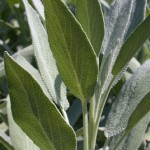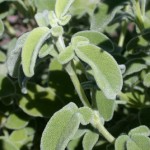 |
 |
 |
Sage, known by Latin epithets such as Salvia salvatrix, was a healing plant of great renown throughout the Middle Ages, although it was also valued as a culinary herb. Above, left: Salvia officinalis, the common garden sage, growing in a bed devoted to kitchen plants in Bonnefont garden; center: a detail from The Unicorn is Found, showing Salvia officinalis in flower; right: Greek sage or three-lobed sage (Salvia fruticosa) is not hardy in our climate, and is grown in pots and brought under cover in winter. The medicinal properties of this species were celebrated in antiquity and were conflated with those of S. officinalis.
Why should a man die in whose garden grows sage?
Against the power of death there is not medicine in our gardens
But Sage calms the nerves, takes away hand
Tremors, and helps cure fever.
Sage, castoreum, lavender, primrose,
Nasturtium, and athanasia cure paralytic parts of the body.
O sage the savior, of nature the conciliator!???From Page Ten of the Regimen Sanitatis Salernitanum (A Salernitan Regimen of Health). See the Gode Cookery website to read the entire poem.
Cur moriatur homo cui salvia crescit in horto? (Why should a man die who has sage growing in his garden?) This much-quoted Latin adage is from the famous medieval didactic poem on maintaining good health, the Regimen Sanitatis Salernitanum. (Salerno was the site of the first lay school of medicine in Europe. See the National Library of Medicine website for more about Salerno.) The proverb is one of many examples linking sage and longevity, e.g., the old English saw “He who would live for aye must eat sage in May.” The name salvia is derived from the Latin verb salvere, or “to save,” another tribute to its medicinal virtue.
The fame of sage as a healing herb goes back to Greek antiquity, but it may be that the virtues of Salvia fruticosa were conflated with those of Salvia officinalis in the European Middle Ages. The sixteenth-century English herbalist John Gerard was familiar with both species, but considered S. fruticosa to be of greater medicinal value. Ethnopharmacologists investigating both historical and contemporary uses of this plant in western Europe suggest that it may have been Salvia fruticosa, common both in the wild and in gardens in the vicinity of modern Salerno, that was the inspiration for the adage quoted above.
Sage was known to Theophrastus and other ancient authors such as Dioscorides as elelisphakon, although the latter gives a number of other names, including salvia.?? The names and virtues originally attributed to S. fruticosa seem to have been amalgamated??with those recorded for S. officinalis.?? (See the Index of Medieval Medical Images for a representation of common sage in a fourteenth-century Italian herbal.) In contemporary Mediterranean folk medicine, the uses of the two species are complementary rather than identical.
Dioscorides recommends a decoction of sage leaves and stems as a diuretic, an abortifacient, a wound herb, a styptic, an antitussive and an antiprurient. Drunk with white wine, sage is said to be good for dysentery and cures blood-spitters (De Materia Medica, III.40). He also notes that water in which sage has been boiled can be used to dye the hair black.
Sage (Salviam) appears in the famous ninth-century edict the Capitulare de villis, in which the emperor Charlemagne decreed which useful plants were to be grown on the imperial estates. The Benedictine abbot Walahfrid Strabo
includes a salutation to sage, which he ranks first among herbs in a delightful poem known as the Hortulus:
There in the very front glows sage, sweetly scented,
It deserves to grow green for ever, enjoying perpetual youth;
For it is rich in virtue and good to mix in a potion,
Of proven use for many a human ailment . . .???From Hortulus by Walahfrid Strabo. Translated from the Latin by Raef Payne. The Hunt Botanical Library, 1966.
It seems unlikely that the tender Salvia fruticosa would have grown in Walahfrid’s garden, situated near Lake Constance near the northern foot of the Alps. The hardier Salvia officinalis was more likely to be cultivated in northern European gardens.
Hildegard of Bingen considers the warming, drying properties of sage to be useful against all ill humors. She recommends sage cooked in wine for excessive phlegm, as Dioscorides had, but also maintains its value as a cure for palsy and paralysis. The Herbarius Latinus, printed in Germany in the fifteenth century, recommends an ointment made from sage for palsy and paralysis, and recapitulates the virtues mentioned by Dioscorides, including the use of sage to darken the hair, not mentioned by Hildegard.
The Tacuinum Sanitatis, while recommending sage for paralysis, warns that there is a danger that the consumption of sage leaves will remove the dark color from hair; over the course of fourteen hundred years, a little confusion is bound to enter into the tradition.
???Deirdre Larkin
Sources:
Arano, Luisa Cogliati. The Medieval Health Handbook: Tacuinum Sanitatis. New York: George Braziller, 1976.
Anderson, Frank J., ed. “Herbals through 1500,” The Illustrated Bartsch, Vol. 90. New York: Abaris, 1984.
Grieve, Maude. A Modern Herbal. 1931. Reprint: New York: Dover Publications, 1971.
Griffiths, Mark. The New Royal Horticultural Society Index of Garden Plants. Portland, OR: Timber Press, 1992.
Gunther, Robert T., ed. The Greek Herbal of Dioscorides, translated by John Goodyer 1655. 1934. Reprint: New York: Hafner Publishing, 1968.
Riviera, Diego, Conchita Obon, and Francisco Cano. “The Botany, History and Traditional Uses of Three-Lobed Sage (Salvia Fruticosa Miller)(Labiatae).” Economic Botany 48 (2) pp. 190-195. Bronx, NY: The New York Botanical Garden, 1994.
Throop, Priscilla, transl. Hildegard von Bingen’s Physica: The Complete English Translation of Her Classic Work on Health and Healing. Rochester, VT: Healing Arts Press, 1998.
Tags: culinary herb, Dioscorides, Gode cookery, rugose, sage, salvia fruticosa, salvia officinalis, salvia salvatrix, Theophrastus
